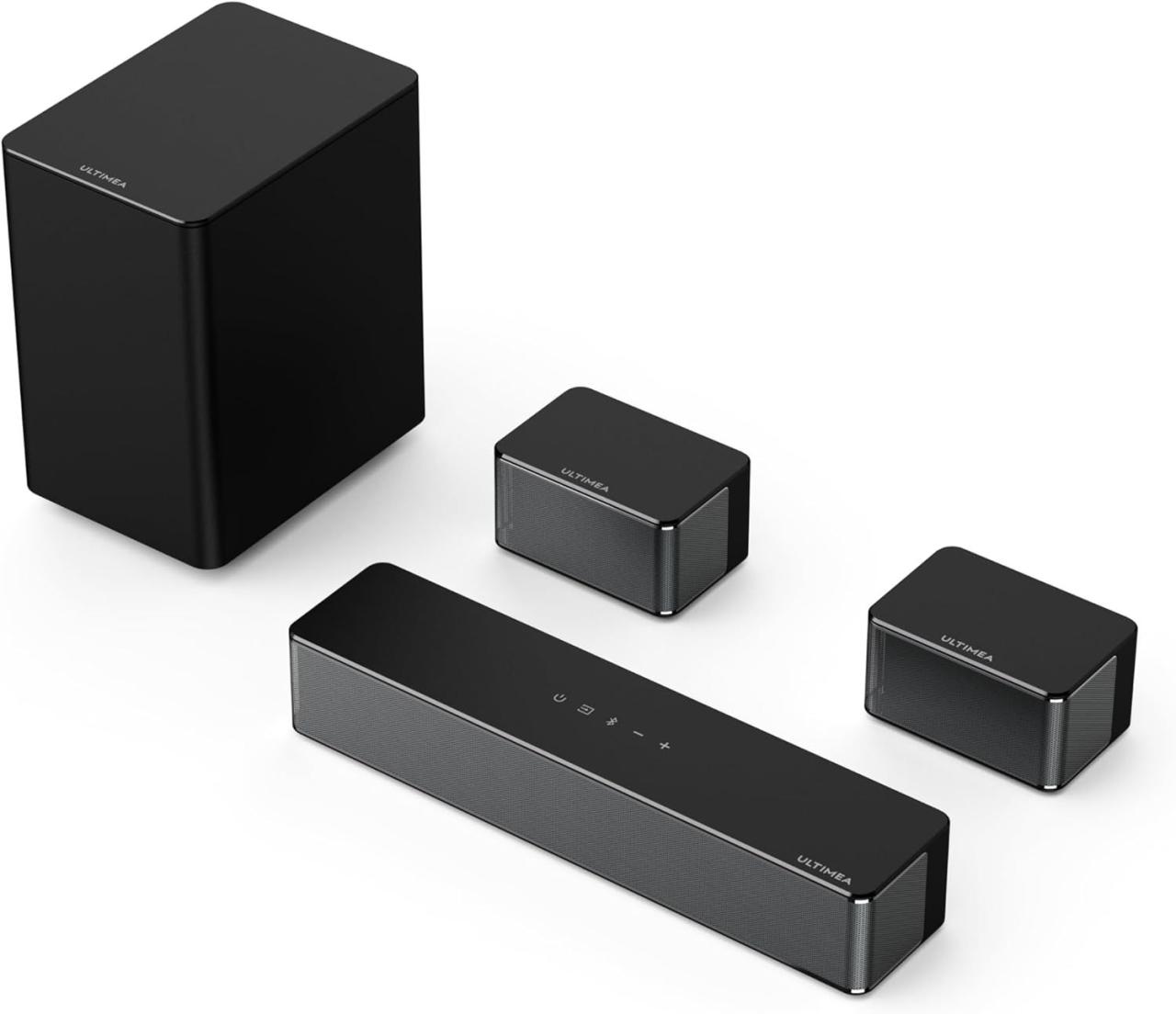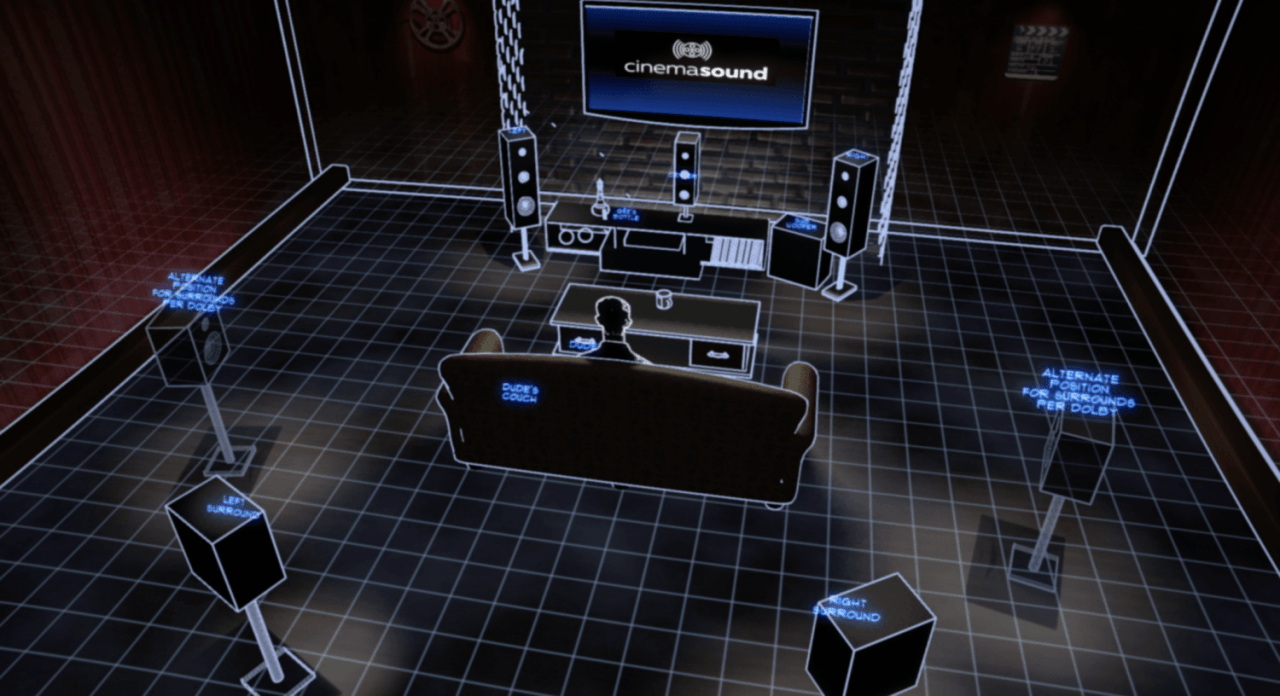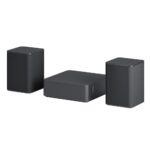9 Must-Have Accessories for the Perfect Surround Sound Setup sets the stage for an in-depth exploration of the key components essential for an exceptional audio experience, offering insights into the intricacies of creating an immersive surround sound environment.
The discussion delves into various accessories like speakers, subwoofers, AV receivers, speaker stands, soundproofing elements, speaker wires, smart home integration, and calibration tools, each playing a crucial role in achieving the perfect surround sound setup.
Essential Accessories for Surround Sound Setup

To achieve the perfect surround sound setup, there are several essential accessories that play a crucial role in enhancing the audio experience and creating an immersive environment.
1. High-Quality Speakers
Investing in high-quality speakers is the foundation of a surround sound setup. They deliver clear and crisp audio, bringing out the full range of sound effects in movies, music, and games.
2. Subwoofer
A subwoofer is essential for producing deep bass frequencies that add richness and depth to the audio. It enhances the overall sound quality and creates a more realistic listening experience.
3. AV Receiver
An AV receiver acts as the central hub for your surround sound system, connecting all your audio and video components. It decodes audio signals and distributes them to the speakers, ensuring synchronized sound output.
4. Speaker Stands or Wall Mounts
Proper placement of speakers is crucial for optimal sound quality. Speaker stands or wall mounts help position the speakers at the correct height and angle, maximizing their performance.
5. Speaker Wire
Quality speaker wire is essential for transmitting audio signals from the AV receiver to the speakers without interference or signal loss. Using the right gauge and length of wire is critical for maintaining audio quality.
6. Soundproofing Materials
Soundproofing materials help minimize sound reflections and external noise, creating a more immersive listening environment. Acoustic panels, rugs, and curtains can improve sound clarity and reduce distractions.
7. Remote Control or Smart Home Integration
Having a remote control or smart home integration allows you to easily adjust audio settings, volume levels, and switch between different sound modes. It enhances the convenience and user experience of your surround sound system.
8. Cable Management System
A cable management system keeps your wires organized and prevents clutter, ensuring a neat and tidy setup. It also helps maintain the integrity of the audio signal by reducing interference from other electronic devices.
9. Calibration Microphone
A calibration microphone helps optimize the audio settings of your surround sound system by measuring the acoustic properties of your room. It ensures that sound is balanced and consistent across all speakers, delivering a more accurate listening experience.
Speakers
When it comes to setting up a surround sound system, the type of speakers you choose can make a significant difference in the overall audio quality of your setup. Different types of speakers serve different purposes and are designed to be used in specific ways to create an immersive audio experience.
Types of Speakers
- Floor-standing Speakers: These are large speakers that are designed to sit on the floor and typically produce powerful, full-range sound. They are ideal for larger rooms and can deliver deep bass and clear highs.
- Bookshelf Speakers: These compact speakers are designed to be placed on shelves or stands. While they may not produce as much bass as floor-standing speakers, they are great for smaller rooms or for use as surround or rear speakers in a home theater setup.
- Satellite Speakers: Satellite speakers are small, usually compact speakers that are designed to be mounted on walls or placed on stands. They are commonly used as surround or rear speakers in a home theater system and are great for creating a more immersive audio experience.
Speaker Configurations
- Floor-standing vs. Bookshelf: Floor-standing speakers are larger and more powerful, making them ideal for main front speakers in a surround sound setup. Bookshelf speakers, on the other hand, are more compact and versatile, making them great for surround or rear speakers.
- Satellite Speakers vs. Bookshelf: Satellite speakers are smaller and more discreet, making them perfect for use as surround or rear speakers. Bookshelf speakers, while larger, can still be used effectively in a surround sound system, especially if space is not an issue.
Placement and Positioning
- For optimal sound quality, it is essential to position your speakers correctly. Front speakers should be placed at ear level, slightly angled towards the listener for the best sound projection.
- When setting up surround speakers, place them behind or to the sides of the primary listening area to create a more immersive sound experience.
- Subwoofers, which handle low-frequency sound, can be placed anywhere in the room, but for the best bass response, experiment with different placements to find the optimal position.
Subwoofers

The subwoofer is a crucial component in a surround sound system as it is responsible for reproducing low-frequency sounds, commonly known as bass. This adds depth and richness to the audio, enhancing the overall listening experience.
Impact of Subwoofers on Low-Frequency Audio Reproduction
Subwoofers play a vital role in delivering powerful and impactful bass that can be felt as well as heard. They are designed to handle lower frequencies that regular speakers might struggle to reproduce accurately. This results in a more immersive sound experience, especially when watching action-packed movies or listening to bass-heavy music.
- Subwoofers enhance the overall dynamics of the audio, creating a more balanced soundstage.
- They provide a sense of realism and depth to sound effects, making explosions, thunder, and other low-frequency sounds more lifelike.
- Subwoofers can also alleviate the strain on other speakers in the system, allowing them to focus on mid and high-range frequencies.
Tips on Optimizing Subwoofer Placement for Balanced Bass Distribution
Proper placement of the subwoofer is crucial to ensure optimal bass response and a well-balanced sound output throughout the listening area. Here are some tips to consider:
- Experiment with subwoofer placement by moving it around the room to find the spot where bass sounds the most balanced and natural.
- Avoid placing the subwoofer in a corner of the room, as this can result in boomy and overpowering bass.
- Consider using bass traps or acoustic panels to help minimize reflections and improve bass clarity.
- Calibrate the subwoofer’s volume and crossover settings to integrate seamlessly with the rest of the speakers in the surround sound system.
AV Receiver: 9 Must-Have Accessories For The Perfect Surround Sound Setup
An AV receiver is a crucial component in a surround sound setup, serving as the central hub for audio and video processing. It acts as the brain of the system, receiving audio and video signals from various sources and distributing them to the speakers and display devices.
Functions and Features, 9 Must-Have Accessories for the Perfect Surround Sound Setup
An AV receiver performs several key functions to enhance the audio experience:
- Power Output: AV receivers come in different power ratings, typically measured in watts per channel. Higher power output allows for greater volume levels and dynamic range.
- Connectivity: Modern AV receivers are equipped with a variety of inputs and outputs, including HDMI, optical, and coaxial connections, to accommodate multiple audio and video sources.
- Surround Sound Formats: AV receivers support various surround sound formats such as Dolby Atmos, DTS:X, and IMAX Enhanced, providing an immersive audio experience.
Calibration Process
Calibrating an AV receiver is essential to ensure accurate sound reproduction tailored to the listening environment. The process typically involves:
- Speaker Configuration: Setting up the correct speaker layout, including speaker size, distance, and placement, to optimize sound quality.
- Room Correction: Utilizing built-in calibration systems like Audyssey or room EQ to analyze room acoustics and make adjustments for optimal audio performance.
- Sound Optimization: Fine-tuning audio settings such as crossover frequencies, channel levels, and equalization to achieve balanced sound output.
Speaker Stands and Mounts
Speaker stands and mounts play a crucial role in optimizing the placement of your speakers for the perfect surround sound setup. By using stands and mounts, you can achieve improved sound projection and overall audio quality in your home entertainment system.
Importance of Speaker Stands and Mounts
When it comes to setting up your speakers, their placement can significantly impact the sound quality you experience. Speaker stands and mounts help elevate your speakers to the optimal height for better audio dispersion and clarity. By positioning your speakers at ear level and away from walls or corners, you can avoid sound distortion and enjoy a more immersive listening experience.
Benefits of Using Stands and Mounts
Enhanced sound projection
Speaker stands and mounts allow you to position your speakers at the ideal angle and distance for optimal sound dispersion, resulting in a more immersive audio experience.
Reduced vibrations
Stands and mounts provide a stable and isolated platform for your speakers, minimizing vibrations that can affect sound quality and clarity.
Neater setup
By using stands and mounts, you can declutter your space and create a more organized and aesthetically pleasing home theater setup.
Guidelines for Selecting Stands or Mounts
When choosing speaker stands or mounts, consider the following factors:
Speaker type
Ensure that the stands or mounts are compatible with the size and weight of your speakers to provide adequate support.
Room layout
Take into account the layout of your room and the listening positions to determine the ideal placement of the speakers for optimal sound delivery.
Adjustable features
Look for stands or mounts with adjustable height and tilt options to customize the speaker positioning according to your preferences.
Cable management
Opt for stands or mounts that offer cable management solutions to keep wires organized and prevent tangling.Consider these guidelines when selecting speaker stands or mounts to enhance the performance of your surround sound system and elevate your listening experience.
Soundproofing and Acoustic Treatment
Soundproofing and acoustic treatment play a crucial role in creating the perfect surround sound setup. By minimizing unwanted noise and optimizing the acoustics of your room, you can enhance the overall audio experience.
Acoustic Panels, Bass Traps, and Diffusers
Acoustic panels, bass traps, and diffusers are essential accessories for improving sound quality in your surround sound system. Acoustic panels absorb sound waves, reducing reflections and echoes in the room. Bass traps help in controlling low-frequency sound waves, preventing muddiness in the audio. Diffusers scatter sound waves, creating a more balanced and natural acoustic environment.
- Acoustic panels: These panels are typically made of absorbent materials like foam or fabric and can be strategically placed on walls to reduce sound reflections.
- Bass traps: Placed in corners of the room, bass traps absorb low-frequency sound waves, preventing unwanted bass buildup and ensuring a cleaner sound.
- Diffusers: Diffusers scatter sound waves in different directions, helping to create a more even distribution of sound throughout the room and reducing harsh reflections.
Creating a Balanced Acoustic Environment
To minimize sound reflections and echoes in your surround sound setup, consider the following tips:
- Strategically place acoustic panels on walls where sound reflections are prominent, such as behind the speakers or around listening areas.
- Use bass traps in room corners to address low-frequency issues and maintain a well-balanced sound.
- Experiment with diffusers in areas where sound waves tend to bounce off surfaces, ensuring a smoother sound dispersion.
- Consider the overall room layout and furniture placement to optimize sound absorption and diffusion for a more immersive audio experience.
Speaker Wire and Cables
Speaker wire and cables play a crucial role in connecting various audio components in a surround sound system. They transmit the audio signal from the AV receiver to the speakers, ensuring that the sound is delivered accurately and without interference.
Types of Speaker Wires and Cables
- Gauge: Speaker wire gauge refers to the thickness of the wire. Thicker wires (lower gauge numbers) have less resistance and can carry more current, making them suitable for longer cable runs.
- Material: Copper is the most common material used for speaker wires due to its excellent conductivity. Some high-end cables may use silver or gold-plated connectors for enhanced signal transmission.
- Insulation: Insulation around the wires helps prevent interference and signal loss. Look for cables with high-quality insulation to maintain signal integrity.
Importance of High-Quality Cables
Using high-quality speaker wires and cables is essential for preserving the integrity of the audio signal. Low-quality cables can introduce noise, distortion, and signal loss, resulting in a degraded listening experience. Investing in good cables ensures that the sound is transmitted accurately from the source to the speakers, maximizing the performance of your surround sound system.
Remote Control or Smart Home Integration
Having a remote control or smart home integration for your surround sound system can greatly enhance the overall user experience by providing convenience and ease of operation. With just a touch of a button or a voice command, you can control all aspects of your audio setup without having to get up from your seat.
Features of Smart Home Devices
- One-touch control: Smart home devices allow you to control multiple components of your surround sound system with just one touch, simplifying the operation process.
- Voice control: Many smart home devices come equipped with voice-controlled assistants like Amazon Alexa or Google Assistant, enabling you to manage your audio setup using voice commands.
- Integration with other smart devices: Smart home devices can be integrated with other smart home gadgets, creating a seamless and interconnected ecosystem for your entertainment needs.
- Personalization: Smart home devices offer customizable settings and preferences, allowing you to tailor your surround sound experience to your liking.
Voice-Controlled Assistants
- Amazon Alexa: Alexa can adjust volume levels, switch between audio sources, and even play specific songs or playlists on your surround sound system.
- Google Assistant: Google Assistant can help you control your AV receiver, change sound modes, and provide information about the content you are watching or listening to.
- Apple Siri: Siri can also be used to control your surround sound system, offering a hands-free way to adjust settings and preferences.
Calibration Tools and Apps
Calibration tools and apps play a crucial role in optimizing the audio settings of a surround sound system to deliver the best sound quality possible. These tools help ensure that the audio output is accurate and balanced, providing an immersive listening experience.
Benefits of Calibration Tools
- Ensure accurate sound reproduction: Calibration tools help fine-tune the audio settings to achieve a balanced sound output across all speakers.
- Optimize audio performance: By calibrating the surround sound system, you can make the most of your speakers, subwoofers, and AV receiver to deliver optimal sound quality.
- Eliminate sound inconsistencies: Calibration tools help identify and correct any discrepancies in sound levels or frequencies, ensuring a seamless audio experience.
How to Calibrate a Surround Sound System
- Set up your surround sound system in the desired configuration, ensuring all speakers are properly placed and connected to the AV receiver.
- Download a calibration app or use a dedicated calibration tool provided by the manufacturer of your AV receiver.
- Follow the on-screen instructions of the calibration tool to start the calibration process.
- Place the calibration microphone at the primary listening position in the room, typically at ear level.
- Run the calibration tool to measure the audio output from each speaker and adjust the settings accordingly.
- Repeat the calibration process if necessary to fine-tune the audio settings for optimal sound quality.
Outcome Summary

In conclusion, the meticulous selection and integration of these 9 must-have accessories pave the way for a truly remarkable surround sound experience, elevating your audio setup to new heights of sonic excellence.
Query Resolution
How do speaker stands and mounts contribute to optimizing sound quality?
Speaker stands and mounts play a crucial role in elevating speakers to ear level, ensuring better sound projection and minimizing unwanted vibrations, leading to improved audio clarity and balance.
Why is calibration essential for a surround sound system?
Calibration helps fine-tune audio settings, ensuring accurate sound reproduction by adjusting speaker levels, distances, and frequencies to create a harmonious and immersive surround sound experience.




